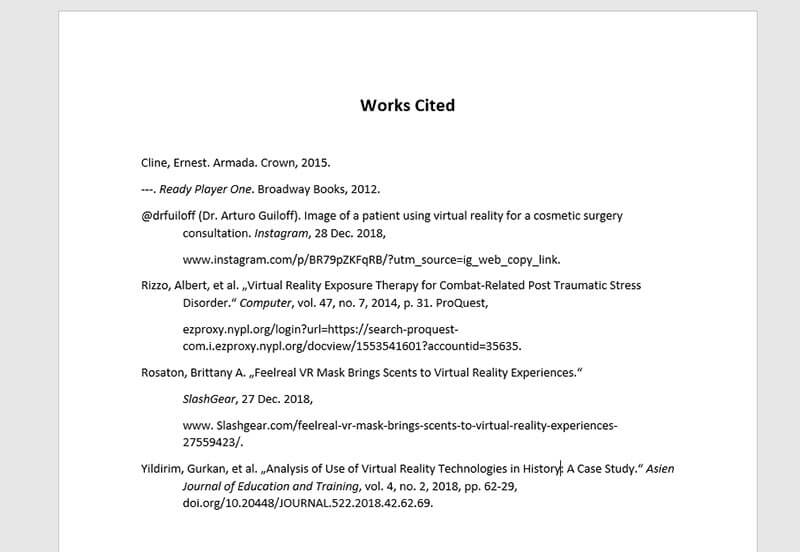
Works Cited: Definition
The works cited page shows the sources you have used in your research. This page is included at the end of your study, and it includes the sources used for the following types of data:
- Facts and data that is not common knowledge
- Words and theories that someone else came up with
- Direct quotes from other authors
FAQs
The works cited section of your research paper should clearly indicate the sources you used to get ideas and content for your research paper, thesis or dissertation. It also allows you to acknowledge and appreciate the works of other researchers and avoid plagiarism. However, the works cited and bibliography are not to be confused with one another.
You should include an in-text citation when you’re referring to, summarising or quoting another author. It’s important that the in-text reference also appears in the bibliography at the end of the paper. This helps you avoid accidentally plagiarizing other people’s work. Plus, the references also serve as a guide for readers of your thesis or research paper.
Yes, you can quote words from authors as long as you show the source in the works cited page. This allows you to adequately convey thoughts or ideas about the subject area you are discussing in your paper. This can also be done in the format of any of the numerous referencing and citation styles.
The works cited page should show unique findings, data, statistics, ideas, theories, and quotes which have been picked from a primary or secondary source. This especially includes the sources from extra reading that you may have done on your research topic. If you are unsure as to whether you should cite a source for certain information, it’s always better to be safe than sorry. That source would have a place either on a works cited page, or a bibliography.
There are various consequences for failing to include a source in the works cited section, or even in a bibliography. You risk being accused of plagiarism. Some professors will penalize you for the mistake if it’s minor, but in some severe cases, you may be forced to leave your institution if there’s substantial evidence that you have plagiarized your thesis.
Yes, there is a difference between these two sections. In a bibliography, every single source that has been used by the author, whether it was cited directly in the text or not needs to be concluded. Even if it was used for some extra reading, it needs to be included. However, the works cited page simply shows the sources the author used directly in the creation of the academic paper.
Yes, you can add a subtitle to make a reference in your term paper or essay. You will simply have to place a colon between the title and subtitle. However, if the subtitle is intended to standalone, it should be written in italics.
Example in MS Word
Here is a works cited page example that used internet sources and print sources:

- ✓ 3D live preview of your individual configuration
- ✓ Free express delivery for every single purchase
- ✓ Top-notch bindings with customised embossing

APA format
There are different formats of the works cited page. One of these formats is referred to as APA or America Psychology Association. Works cited in APA citation style should show the names of the author, the title of the source, and the town or city. The works cited section should also indicate the type of source that was used to get the information. This could be the internet, a print source, or even a database. Here are some examples of works cited in APA format:
Wynne, T. (2015). The art of building an empire. Sommerville: MA, Candlewick Press.
Micheal, J.W. (2014). 101 Tips Success. https://michaelljohnson.com.
Mary, Beth, (2002). Effect of Financial Technology on the Economy. London University Press, Volume 3 (Issue 10), pp. 10.
Leonard W. R. & Crawford M. H. (Eds.). (2002). Human biology of pastoral populations. Cambridge, NY: Cambridge University Press.
Editor Surname, A. (Ed.). (YEAR). Book title: Subtitle (# ed.). Retrieved from http://url_of_ebook_database.
Works Cited in MLA Style
In MLA format, the works cited section should show the author of the work, the titles of the works cited, and the publication information. The structure of the works cited will vary based on the type of source of the works cited. For example, print works cited are shown differently from online works cited.
In MLA format, the works cited page will include the following information in this order: Last name, first name. “Title of the Source.” Title of the container, other contributors, the version, numbers, publisher, date of publication, location.
Here are two examples of works cited in MLA format:
Johnson, Mike. “Fruit Flies.” SIU Press, vol 12, no. 3, 2011, pp. 13 to 67.
Davies, Larisa Maclean, et al. “Teaching Australian Literature.” English in Australia , vol 12, no. 3, 2010, pp. 21. ERIC, https://gov.au.literature.
You should note that the names of the author are followed by a full stop. If the source has two authors, place them in the order listed in the source. The first author is listed with the last name then the first name, and the second one is listed in standard form. For the second author, there is no comma between the names.
If the source has more than two authors, you will only list the first author who appears on the source. The name should be in reverse order, and it should be followed by the phrase ‘et al.’ It is also possible to include someone other than the author of the works cited, but you have to indicate the reason why you are including them in the paper.
Primary and Secondary Sources
In research, you can get your data from primary and secondary sources. Primary sources are those which contain an author’s original thoughts and ideas while secondary ones are those which use data from another source. Secondary sources interpret primary sources and are usually in the form of articles, television documentaries, biographies, essays, and critiques.
Primary works cited are typically written by professionals in specific fields, and they can be in the form of diaries, artwork, and speeches. Primary sources of data are cited just like secondary sources. You will include the author or authors, the title of the works cited, the year of publication, and the city of publication. The references can be shown separately or altogether.
In a Nutshell
Here are some key points you should remember about the works cited page:
- It is added at the end of the research paper
- There are different formats used for the citation page. These include APA and MLA
- You should refer to the latest guidelines of the various formats to understand the current acceptable standards
- If you fail to cite a source you used for your research, you can be penalized for plagiarism
- If you are in doubt on whether a particular source should be cited or not, you should go ahead and include it in the list of references
- Titles and subtitles that are shown in their entirety in the works cited section should be written in italics
References
YourDictonary. “Examples of Works Cited Pages”: https://examples.yourdictionary.com/examples-of-works-cited-pages.html. Last accessed 9th Oct 2019
